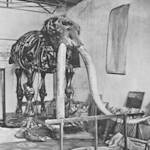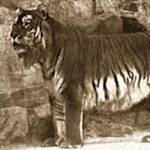Crescent Nail-tail Wallaby
Extinct circa 1956 CE • Western and Central Australia
"The woodlands and scrubs of the west and centre of Australia were once home to the silky-furred crescent nailtail wallaby . . . The crescent nailtail was the smallest member of the genus, resembling a hare in size. One of its more peculiar characteristics was its propensity to seek refuge in a hollow tree when chased, entering at the bottom, and clambering up until it appeared at an opening high above . . . The crescent nailtail wallaby remained common, even in agricultural districts in the south-west of Western Australia, until around 1900. By 1908, however, it had begun a steep decline and the last record from the region dates to that year. It survived in the more arid parts of its distribution until the 1950s. Just what caused its disappearance is still debated, but the spread of the fox seems to be correlated with its loss and may have been the principal factor."
Tim F. Flannery, A Gap in Nature: Discovering the World's Extinct Animals (New York, NY: Atlantic Monthly Press, 2001), 165.
Image: Onychogalea lunata, John Gould, F.R.S., Mammals of Australia, Vol. II Plate 55, London, 1863. Copyright Museum Victoria.


Learn about Maya Lin’s fifth and final memorial: a multi-platform science based artwork that presents an ecological history of our world - past, present, and future.

Discover ecological histories and stories of former abundance, loss, and recovery on the map of memory.

Learn how we can reduce our emissions and protect and restore species and habitats – around the world.

See how art can help us rethink the problems we face, and give us hope that each one of us can make a difference.

Help make a global memorial something personal and close to home. Share your stories of the natural world.


